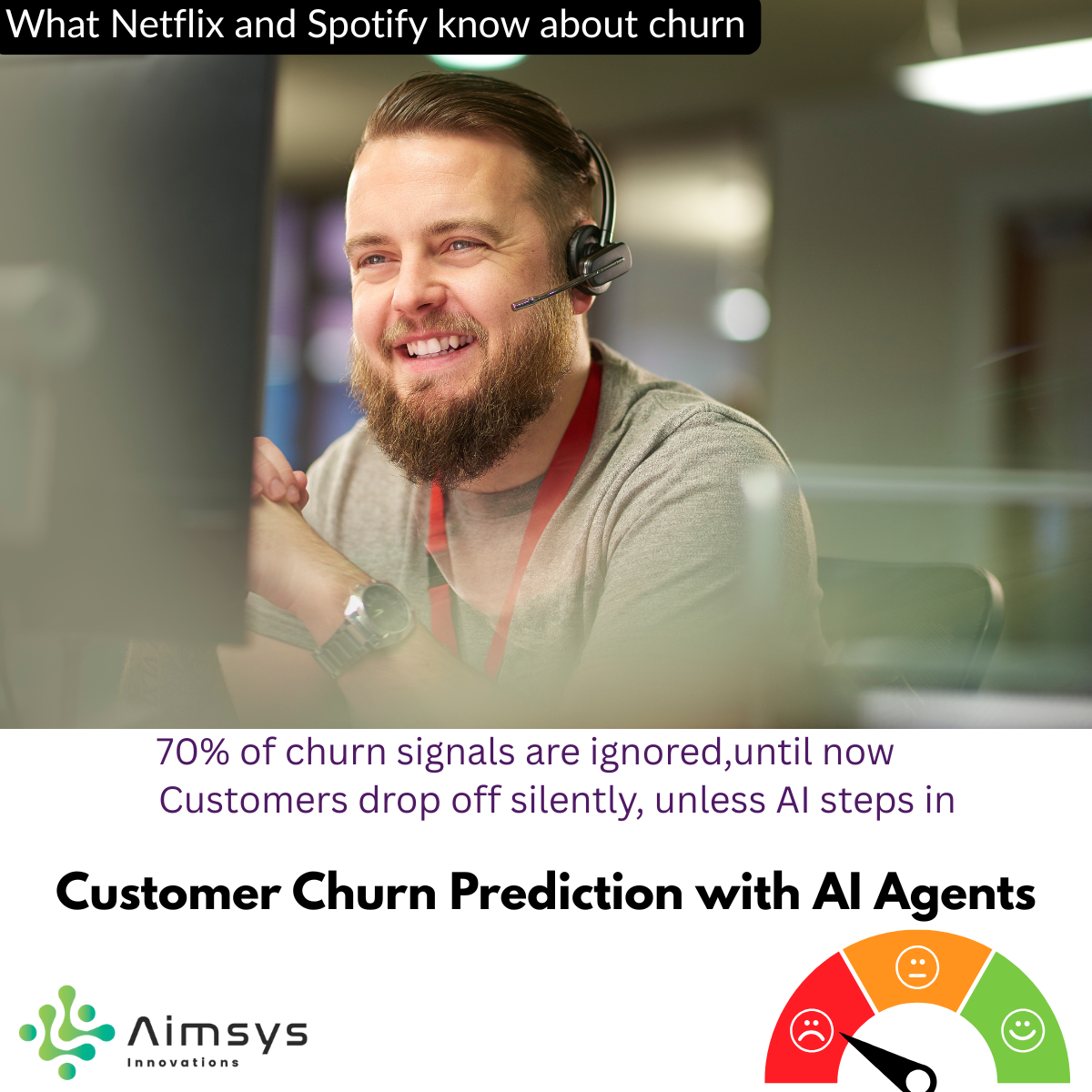Posted At: Jul 30, 2025 - 404 Views

Customer Churn Prediction – Flagging Likely Drop-Offs with Proactive Engagement Using AI Agents
In today’s experience-driven economy, retaining existing customers is just as, if not more important than acquiring new ones. While many businesses understand the importance of reducing customer churn, very few are leveraging the power of AI agentsto do it efficiently and proactively.
Welcome to the era of AI-powered churn prediction, where intelligent agents don’t just identify who’s likely to leave, they take real-time action to keep them.
What Is Customer Churn and Why Does It Matter?
Customer churnrefers to the number of customers who stop using a product or service over a specific time period. It’s a key metric across industries, especially in SaaS, subscription models, telecom, banking, and retail.
High churn = lost revenue, reduced lifetime value (LTV), and increased cost to replace lost users.
Traditionally, churn management involved manual analysis and reactive communication. AI agents, however, flip this model on its head with predictive intelligenceand automated engagement.
Enter AI Agents: The Game Changer in Churn Management
An AI agentis a software system that can perceive, analyze, and act autonomously or semi-autonomously. In the context of churn prediction, these agents:
- Monitor user behavior in real-time
- Predict likelihood of churn
- Engage proactively through tailored interactions
- Learn and adapt over time
This enables businesses to move from reactive support to proactive retention.
How AI Agents Predict and Prevent Churn
🔍 Step 1: Real-Time Behavioral Monitoring
AI agents track user activity patterns across touchpoints, logins, feature usage, time spent, support tickets, drop-off points, etc.
For example:
- A SaaS user stops using a key feature
- An e-commerce buyer hasn't purchased in 60 days
- A banking app user stops logging in after a failed KYC attempt
These behaviors trigger internal alerts.
🧠 Step 2: Churn Risk Scoring with ML Models
Using historical data, machine learning models calculate churn risk scores. Features like:
- Decline in engagement
- Negative sentiment from support interactions
- Subscription downgrade
- Cart abandonment
Each customer is tagged with a churn probability score.
🤖 Step 3: Proactive, Personalized Engagement
Here’s where AI agents shine. Instead of handing over the data to human teams for follow-up, agents take actionautonomously:
- Send tailored emails or offers based on behavior
- Trigger in-app nudges or chat messages
- Assign customer success reps for high-risk users
- Recommend content, features, or products to re-engage
🔁 Step 4: Continuous Learning and Feedback
AI agents don’t just execute, they learn. By monitoring outcomes (e.g., re-engaged users vs. lost ones), the agent retrains itself to improve future prediction accuracy and engagement strategies.
Example Use Case: SaaS Platform with AI Churn Agent
Imagine a SaaS platform using an AI churn agent:
- A user’s activity drops by 70% over two weeks
- The AI agent flags this as high-risk and checks user behavior trends
- It detects that a new feature caused friction
- The agent auto-sends a helpful tutorial video via email + offers a 1:1 onboarding session
- If the user responds positively, their churn score drops and follow-up pauses
- If no engagement occurs, the AI agent alerts a Customer Success Manager with context
This happens without any human prompting saving time and improving retention.
Industries Using AI Churn Agents Effectively
- Telecom: Identifying and retaining subscribers likely to port out
- Banking: Detecting dormant accounts and re-engaging customers via offers
- eCommerce: Predicting high-risk buyers post-refund and nudging them with personalized discounts
- EdTech: Tracking learners likely to drop off and triggering nudges or instructor calls
- Streaming Platforms: Recommending binge-worthy content to prevent subscription cancellations
Top Benefits of Using AI Agents for Churn Prediction
✅ Speed– Real-time detection and engagement
✅ Scalability– Manage thousands or millions of users without added cost
✅ Personalization– Tailored responses based on user behavior
✅ Efficiency– Reduces burden on support and customer success teams
✅ Accuracy– Machine learning improves predictions over time
Popular Tools & Tech Stack
- Customer Data Platforms (CDPs): Segment, Snowplow, mParticle
- AI Agent Platforms: Cresta, Tidio AI, Cognigy, Ada
- ML Frameworks: Scikit-learn, TensorFlow, AWS SageMaker
- Engagement Tools: Intercom, HubSpot, Drift, Braze
Best Practices for Implementing AI Churn Agents
- Start with a clean, well-structured customer dataset
- Identify and define meaningful churn signals
- Choose models based on your business type (classification for subscription churn, regression for revenue risk)
- Always A/B testagent interventions for effectiveness
- Ensure transparency and human handoff for complex cases
AI agents are transforming churn prediction from a lagging metric into a real-time engagement strategy. By combining behavioral intelligence with automated action, businesses can reduce churn, increase retention, and build long-term customer loyalty.
If your churn strategy still relies on static dashboards and delayed follow-ups, it’s time to consider an upgrade. With AI agents, you don’t just spot who’s about to leave, you stop them before they walk away.
